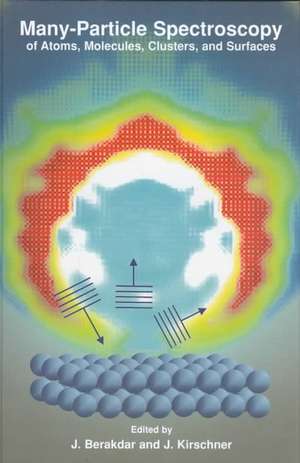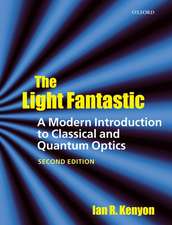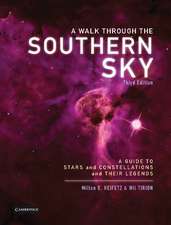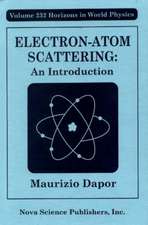Many-Particle Spectroscopy of Atoms, Molecules, Clusters, and Surfaces
Editat de J. Berakdar, J. Kirschneren Limba Engleză Hardback – 30 iul 2001
| Toate formatele și edițiile | Preț | Express |
|---|---|---|
| Paperback (1) | 961.72 lei 6-8 săpt. | |
| Springer Us – 12 oct 2012 | 961.72 lei 6-8 săpt. | |
| Hardback (1) | 969.28 lei 6-8 săpt. | |
| Springer Us – 30 iul 2001 | 969.28 lei 6-8 săpt. |
Preț: 969.28 lei
Preț vechi: 1182.05 lei
-18% Nou
Puncte Express: 1454
Preț estimativ în valută:
185.53€ • 201.60$ • 155.95£
185.53€ • 201.60$ • 155.95£
Carte tipărită la comandă
Livrare economică 21 aprilie-05 mai
Preluare comenzi: 021 569.72.76
Specificații
ISBN-13: 9780306465888
ISBN-10: 0306465884
Pagini: 518
Ilustrații: X, 518 p.
Dimensiuni: 178 x 254 x 29 mm
Greutate: 1.13 kg
Ediția:2001
Editura: Springer Us
Colecția Springer
Locul publicării:New York, NY, United States
ISBN-10: 0306465884
Pagini: 518
Ilustrații: X, 518 p.
Dimensiuni: 178 x 254 x 29 mm
Greutate: 1.13 kg
Ediția:2001
Editura: Springer Us
Colecția Springer
Locul publicării:New York, NY, United States
Public țintă
ResearchDescriere
Since the early days of modem physics spectroscopic techniques have been employed as a powerful tool to assess existing theoretical models and to uncover novel phenomena that promote the development of new concepts. Conventionally, the system to be probed is prepared in a well-defined state. Upon a controlled perturbation one measures then the spectrum of a single particle (electron, photon, etc.) emitted from the probe. The analysis of this single particle spectrum yields a wealth of important information on the properties of the system, such as optical and magnetic behaviour. Therefore, such analysis is nowadays a standard tool to investigate and characterize a variety of materials. However, it was clear at a very early stage that real physical compounds consist of many coupled particles that may be excited simultaneously in response to an external perturbation. Yet, the simultaneous (coincident) detection of two or more excited species proved to be a serious technical obstacle, in particular for extended electronic systems such as surfaces. In recent years, however, coincidence techniques have progressed so far as to image the multi-particle excitation spectrum in an impressive detail. Correspondingly, many-body theoretical concepts have been put forward to interpret the experimental findings and to direct future experimental research. This book gives a snapshot of the present status of multi-particle coincidence studies both from a theoretical and an experimental point of view. It also includes selected topical review articles that highlight the achievements and the power of coincident techniques.
Cuprins
Part I: Coincidence studies on atoms and ions I: Single ionization/excitation processes. 1. Experimental study of interferences in non-coplanar (e,2e) cross sections; A. Murray, F. Read. 2. Ionization of laser oriented sodium atoms by polarized electrons; S. Mazevet, et al. 3. Time-dependent calculation of electron-hydrogen single differential ionization cross sections using pseudostates; D.O. Odero, et al. 4. (e,2e) processes on isoelectronic hydrogen- and alkali-like ions: Scaling laws; L.U. Ancarani, P.A. Hervieux. 5. Asymptotics of the helium bound states; Y.V. Popov, L.U. Ancarani. 6. An application of the Coulomb scattering theory to ionization processes; V.L. Shablov, et al. 7. Exact versus local exchange in distorted-wave Born calculations of electron impact ionisation; P.J.P. Roche, et al. 8. On the influence of using Dirac-Fock rather then density functional potentials in the relativistic DWBA approximation; M. Kampp, et al. 9. Effective potential study of (e, 2e) processes with polarized electrons; U. Lechner, et al. 10. Low energy (e,2e) ionization of argon in the equal energy sharing geometry; S. Mazevet, et al. 11. Low energy inner-valence electron impact ionization of argon; M.A. Haynes, B. Lohmann. 12. Electron-electron coincidence studies in Xenon with precisely tailored equipment; N. Scherer, V. Schmidt. 13. Influence of post collision interaction on the line-shape of auger-electron spectra in electron impact ionisation; B. Paripás, et al. 14. Direct observations in satellite and inner-valencestates of Xe2+; P. Bolognesi, et al. 15. Spin-Flip transitions for the resonantly excited Xe★(6p3/2)N5O2,3O2,3 Auger spectrum; B. Lohmann, U. Kleiman. 16. Multiple scattering processes in ion atom single ionisation; W.R. Cavero, et al. 17. Rescattering of an atomic electron in a time-dependent field; S. Kunikeev. Part II: Coincidence studies on atoms and ions II: Multiple ionization/excitation processes. 18. Recent progress in theory of atomic double photoionization; A.S. Kheifets, et al. 19. The double ionisation of helium by both photon and electron impact; J. Rasch, et al. 20. Is the optical limit approached in coplanar (e,3e) experiments on He at high and intermediate energies? A. Lahmam-Bennani, et al. 21. The role of the momentum transfer in (e,3e) collisions on helium; A. Dorn, et al. 22. Electron-impact double ionization to investigate electron correlation; J.H. Moore, et al. 23. (e,3e) as a two-step process; V.V. Balashov, et al. 24. (e,3e) processes: A brief theoretical review and new ideas; Y.V. Popov, et al. 25. On the importance of the second order term for double excitation processes of helium by charged particles; P.J. Marchalant, et al. 26. (PS, E+E-); J. Ludlow, H.R.J. Walters. 27. Differential measurements of single and multiple ionisation of argon by positron impact; R. Dubois, C. Doudna. Part III: Many-particle spectroscopy of molecules and clusters. 28. A multi-technique investigation of doubl























